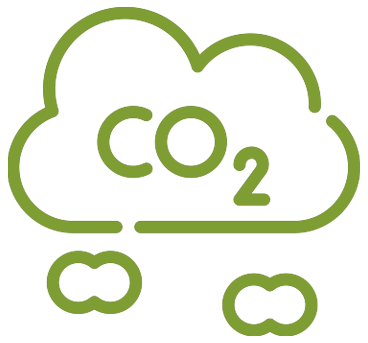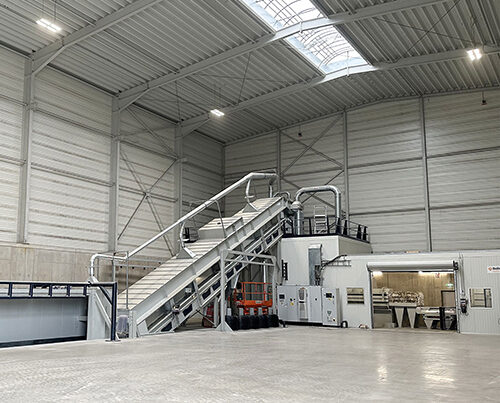More climate action and more sustainability in the passenger and freight transport sectors are one of the cornerstones of German and European climate policies. While progress is being made on the roads thanks to new – primarily EV – concepts and on the railways thanks to green electricity, aviation is still facing some huge hurdles. 2025 will see SARIA – one of REMONDIS’ sister companies – playing a key role in helping the aviation industry to head towards net zero.
Looking at the latest numbers, aviation is responsible for 2% to 3% of global carbon dioxide emissions. And this figure is only likely to grow. Every year, the industry burns through around 375 million tonnes of kerosene. On the other hand, it was worth 261 billion euros in the EU alone in 2022 and it employs more than 900,000 people. Looking ahead, therefore, it will be hugely important for the sector and its business to reduce its emissions and become more climate neutral – but this will also involve complex technical requirements.
Put bluntly: it may be annoying for a driver if their car breaks down, but all they have to do is to pull over to the side of the road. The consequences are far more dramatic if an aircraft breaks down in the air. On top of this, airplane engines deliver a much higher performance and have a longer service life than their counterpart combustion engines on the ground. They are effectively the jewel in the combustion engine crown – making them very difficult to replace.

Looking at the latest numbers, aviation is responsible for 2% to 3% of global carbon dioxide emissions. And this figure is only likely to grow.
A variety of concepts
Airlines and plane manufacturers are currently following different concepts. Synthetic forms of kerosene are categorised as e-fuels, i.e. they are produced using chemical processes involving hydrogen and CO2 with the help of electricity generated from wind and solar power. Roughly speaking, therefore, this process artificially recreates kerosene. The advantage here is that they can be used in existing plane engines. Having said this though, these synthetic fuels are very difficult to get hold of at the moment, their production costs are not competitive and they need additional power generation capacities that still need to be built. Despite all the optimism, there is still much to be done until the point is reached where there are sufficient volumes of synthetic kerosene available on the market at affordable prices.
The assessment of hydrogen as an alternative fuel is similar. It can be used as an aviation fuel either in today’s plane engines after they have been modified or in fuel cells that produce electrical energy. Many other sectors, however, see hydrogen as being the ideal way for them to become net zero – the steel industry, for example, to name just one. There is, therefore, fierce competition among the various sectors to secure the still low hydrogen production capacities. Even if production of hydrogen were to grow rapidly, it is certainly not clear whether the aviation industry would be able to access these additional volumes.
And if we look even further into the future, then there are the electric planes: no matter how enthusiastic a person may be about the futuristic designs, there is no denying the fact that the current small-scale prototypes are far away from covering the range and sizes needed by the aviation industry.
All of which means that sustainable aviation fuels (SAF) will play a key role as the aviation industry takes its first steps towards becoming more sustainable. SAF is a mixture of conventional fossil fuels and synthetic components that have been produced from renewable raw materials. It provides the sector with an alternative to conventional kerosene that is not only practicable but can also be used straight away. SAF can be used in existing aircraft and has the potential to considerably cut carbon emissions – according to experts, by around 80% compared to standard kerosene.

Aviation is facing ever stricter regulations
While a whole number of airlines have already committed – voluntarily – to use SAF, the latest regulations are also heading in the same direction. The EU has prescribed a blending mandate within Europe from 2025 onwards. The minimum share of SAF is to be gradually increased from 2% in 2025 to 70% in 2050. Synthetic forms of kerosene will also be used in the medium to long term to be able to cover the growing demand.
Germany has taken an even more detailed approach as it looks to transpose this EU law. According to the proposals, a minimum 0.5% of kerosene must be synthetically produced as early as 2026. It is, however, still totally up in the air as to whether this requirement will remain in place.
Changes made to the way carbon credits are traded are highly likely to speed up this transition. All airlines operating in Europe have been part of the EU Emission Trading System (EU ETS) since 2012. This means that they must purchase so-called allowances to cover their carbon emissions. Currently, however, they receive approx. 80% of the allowances they require free of charge. These free allowances will no longer be available from 2026 onwards – making alternative solutions more financially attractive.
A great demand
There is a big demand for SAF in the aviation industry and it is increasing all the time. According to the estimates, global demand will have risen to around 20 million tonnes by 2030. In contrast, global production capacities have been put at between 11 and 25 million tonnes. Nothing is set in stone here, however, as only the optimists believe that all the planned projects will actually be implemented.
Current production of SAF covers only a fraction of the overall demand for jet fuel. Production capacity in 2024 is not likely to amount to more than 1.5 million tonnes. This does not even cover 0.5% of the overall demand for jet fuel and would not even be enough – from a global point of view – to meet the EU’s blending mandate for 2025.
A SARIA and TotalEnergies project
Against this backdrop, a biorefinery is currently being built in Grandpuits (France) to produce SAF. Situated on the edge of the Ile-de-France, the completely retrofitted refinery will be producing up to 210,000 tonnes of SAF a year for airlines from 2025 onwards. SARIA and TotalEnergies have set up a joint venture to collaborate on this project.
Being a multi-energy business, TotalEnergies has both the market expertise to produce biofuels and renewable energies and the ideal conditions at its site to produce biokerosene.
First commissioned in 1966, the Total refinery in Grandpuits is currently being converted so that it will be net zero by 2050. On the other side, SARIA, an expert in collecting and recycling organic residue, will be contributing its expertise in the area of feedstock supply for the SAF production. SARIA is the perfect partner for TotalEnergies thanks to its Europe-wide networks dedicated to collecting and recycling used cooking oil (UCO) and animal-based fats from the food and meat industries – both of which can be used to make SAF.

On 30 August 2023, TotalEnergies and SARIA broke ground for the future biofuel production facility in Grandpuits (France)

Three questions for Nicolas Rottmann – the board member of the SARIA Group in charge of the group’s biofuel division
To be able to produce SAF, you need to have the right raw materials from your organic waste collection schemes. Where do these materials come from?
Nicolas Rottmann: Sustainable biogenic materials are the feedstock used to produce SAF. We get hold of these by collecting used cooking oil and fats from the food sector, for example from restaurants and takeaway businesses. At the same time, we also use fats produced from animal by-products. These generally come from local businesses such as abattoirs, butchers and farms. They also include fats made from category 1 and category 2 animal by-products. Certain fats from category 3 animal by-products may now also be recycled.
All of the materials that are collected and further processed are not fit for human consumption. This means that the production of biokerosene is not competing with the food production industry. Producing SAF from used cooking oil and fats is an innovative way to enable valuable raw materials to be recovered and reused for other purposes.
What makes this joint venture so special?
Nicolas Rottmann: This collaboration project links up the various stages of the supply chain – from the collection of the organic residue, to the marketing of biofuels, all the way through to the production of sustainable aviation fuel. Thanks to this project, we are doing our part to help make sure European airports have access to secure supplies of SAF and, by doing so, supporting the European Union’s requirement for the aviation sector to use more SAF over the coming years. Together, TotalEnergies and SARIA will be actively shaping the future of sustainable aviation from their site in Grandpuits.
How do you see SAF production developing in the future?
Nicolas Rottmann: The market for SAF is secure – as far as legislative matters are concerned – thanks to the ‘Fit-for-55’ package which the European Union launched to reduce its greenhouse gas emissions by at least 55% by 2030. From 2025 onwards, airlines will have to ensure that 2% of the fuel they need in the EU is covered by SAF and this figure should have risen to 70% by 2050 as a result of the ReFuelEU Aviation regulation. This means that there will be a huge increase in demand. At the moment, however, we are concentrating on getting our production operations up and running in Grandpuits next year.
SARIA is a German family-run business and a sister company to REMONDIS and Rhenus. Committed to the circular economy, its wide range of activities, products and services focus on collecting organic resources and transforming them into renewable energies and high-quality materials for use in the food, animal feed, pet food and pharma industries. The company is based in Selm in the region of Westphalia and employs around 13,000 people in 26 countries.

Image credits: image 1: Adobe Stock: OleksandrZastrozhnov; image 2: Adobe Stock: Synaptic Studio; image 3: Adobe Stock: Darunee; image 4, 5: © SARIA












